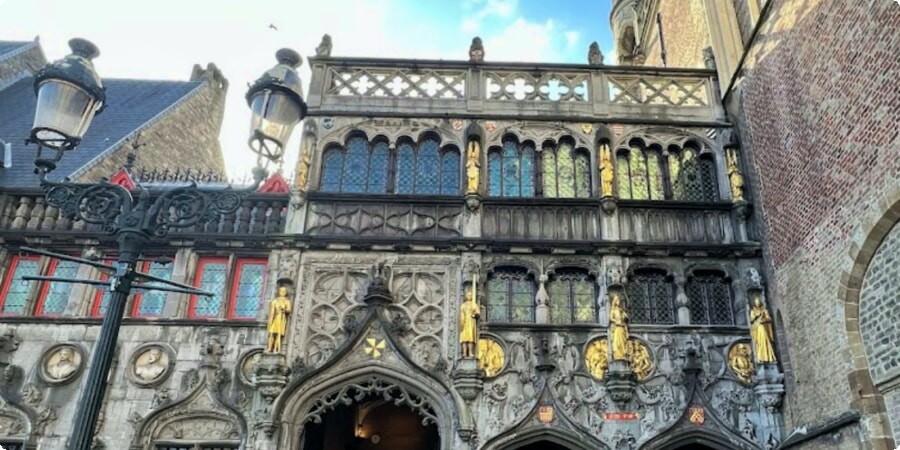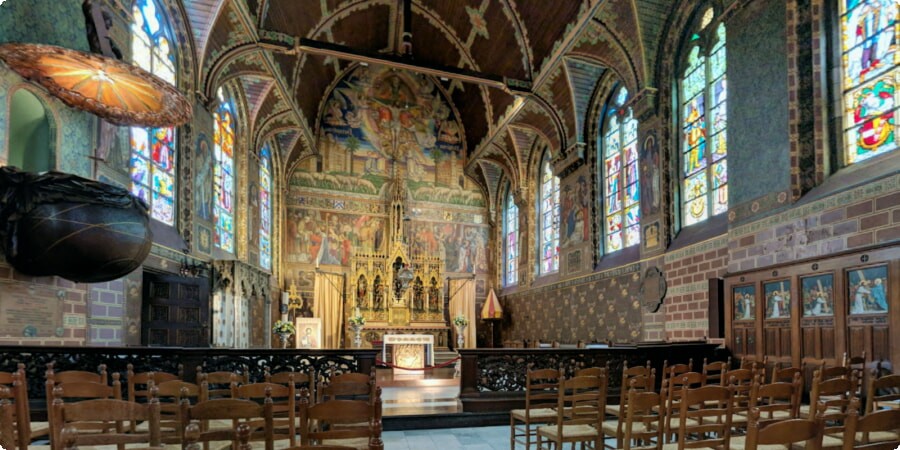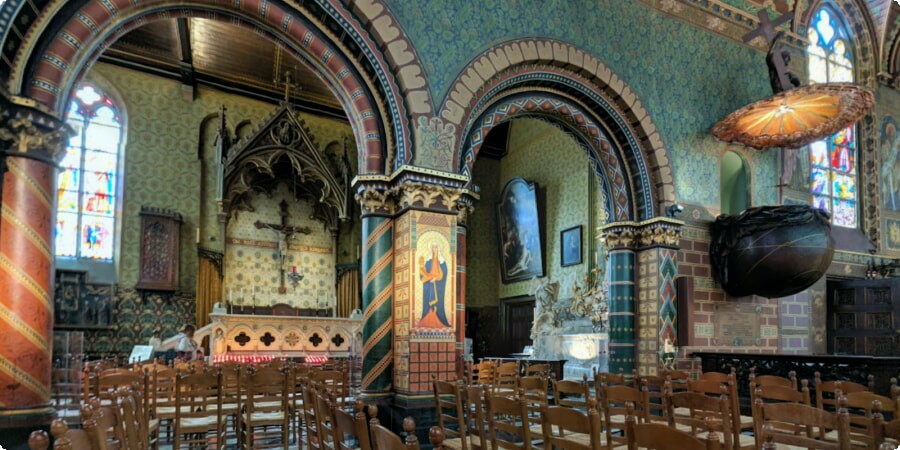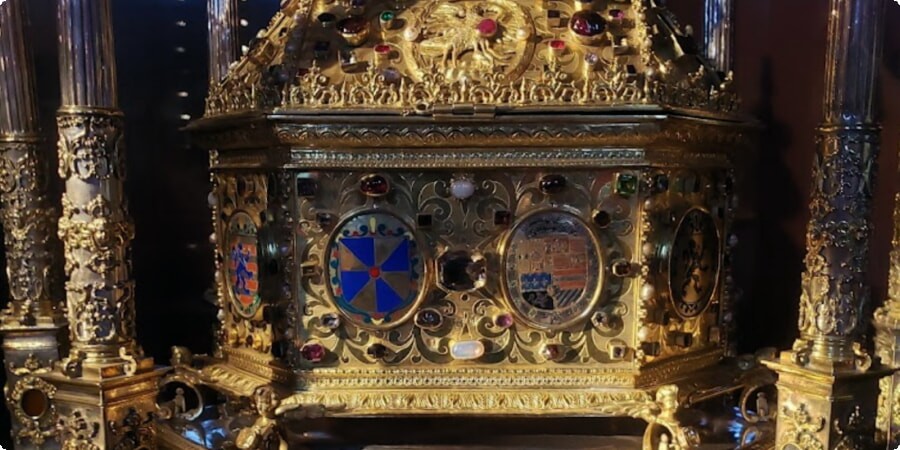The Basilica of the Holy Blood, nestled in the heart of Bruges, Belgium, is a site of immense historical and religious significance. This unique basilica is renowned for housing a revered relic: a vial said to contain a cloth stained with the blood of Jesus Christ. According to legend, this relic was brought to Bruges during the Second Crusade by Thierry of Alsace, Count of Flanders, in the 12th century. Since then, it has attracted countless pilgrims and visitors from around the world.
The basilica itself is an architectural marvel, divided into two distinct levels. The lower chapel, dedicated to Saint Basil the Great, dates back to the 12th century and is built in the Romanesque style. It contrasts beautifully with the upper chapel, which was renovated in the Gothic style during the 16th century. This blend of architectural styles adds to the basilica's unique charm and historical value.
Architectural Highlights
As you step into the Basilica of the Holy Blood, you are immediately struck by its architectural grandeur. The lower chapel, with its austere Romanesque design, exudes a sense of solemnity and reverence. Its dimly lit interior, characterized by sturdy columns and rounded arches, transports visitors back to the early days of medieval Europe.
In contrast, the upper chapel dazzles with its Gothic splendor. The vibrant stained glass windows, intricate woodwork, and elaborate altarpieces are a feast for the eyes. One of the most striking features of the upper chapel is the reliquary of the Holy Blood, an ornate silver tabernacle that houses the sacred relic. This reliquary is a masterpiece of Gothic craftsmanship, adorned with intricate carvings and precious stones.
For a detailed exploration of the architectural styles and history of the basilica, you can refer to the Basilica of the Holy Blood on Wikipedia. Additionally, to navigate your visit, you can use Google Maps for precise directions.

The Holy Blood Relic
The highlight of the basilica is undoubtedly the relic of the Holy Blood. This vial, containing what is believed to be a cloth with the blood of Jesus Christ, is enshrined in a beautiful silver tabernacle in the upper chapel. The relic is brought out for veneration every Friday, allowing visitors to witness this sacred object up close.
The history of the relic is shrouded in mystery and legend. It is said that the relic was given to Count Thierry of Alsace by the Patriarch of Jerusalem in 1149, as a reward for his bravery during the Second Crusade. The relic has been preserved in Bruges ever since, making the basilica a major pilgrimage site.
The relic is also the focal point of the annual Procession of the Holy Blood, held every Ascension Day. This grand event sees the relic paraded through the streets of Bruges, accompanied by a colorful procession of historical reenactments, religious figures, and local dignitaries. The procession is a vibrant display of Bruges' rich cultural and religious heritage, drawing visitors from all over the world.
To make the most of your visit to Bruges and explore its many historical sites, consider renting a car for convenience and flexibility. You can book a car in Brussels through this car rental service.
Stay tuned for the next sections, where we will delve into the cultural significance of the basilica, tips for visiting, and nearby attractions that you can explore to enrich your journey through this beautiful medieval city.
Cultural Significance
The Basilica of the Holy Blood holds profound cultural significance in Bruges and beyond. This sacred site is not only a place of worship but also a symbol of the city's historical connection to the Christian faith. The relic housed within the basilica has been a focal point for religious devotion for centuries, attracting pilgrims and believers from all corners of the globe.
One of the most notable cultural events associated with the basilica is the annual Procession of the Holy Blood. This event, which dates back to the Middle Ages, is held every Ascension Day and showcases a vibrant parade through the streets of Bruges. Participants dressed in historical costumes reenact scenes from the Bible and the history of Bruges, culminating in the solemn display of the Holy Blood relic. This procession is a UNESCO Intangible Cultural Heritage event, underscoring its importance to the cultural fabric of the region.
The basilica also serves as a venue for various religious and cultural activities throughout the year, including concerts, art exhibitions, and special masses. Its role as a cultural hub in Bruges makes it a must-visit for anyone interested in the rich history and traditions of this medieval city.

Tips for Visiting
Visiting the Basilica of the Holy Blood is a memorable experience that requires some preparation to fully appreciate its significance and beauty. Here are some tips to ensure you make the most of your visit:
-
Check Opening Hours: The basilica is usually open to visitors daily, but it’s advisable to check the official website for the most up-to-date information on opening hours and any special events or closures.
-
Dress Modestly: As a place of worship, visitors are expected to dress modestly. Ensure your attire is respectful of the religious setting, especially if you plan to attend a service or view the relic.
-
Attend a Service: If possible, try to attend a mass or the weekly veneration of the Holy Blood relic. This offers a unique opportunity to witness the religious practices and traditions that have been preserved for centuries.
-
Explore Both Chapels: Don’t miss out on visiting both the lower and upper chapels. Each offers a different architectural and spiritual experience that enriches your understanding of the basilica’s history.
-
Guided Tours: Consider joining a guided tour to gain deeper insights into the history, architecture, and cultural significance of the basilica. Knowledgeable guides can provide fascinating stories and details that you might miss on your own.
For convenient transportation around Belgium, you might want to rent a car. It provides flexibility to explore not just Bruges, but other historical and cultural sites throughout the country. You can book a car in Belgium through this car rental service.
Nearby Attractions
Bruges is a city steeped in history and charm, and the Basilica of the Holy Blood is just one of many attractions you can explore. Here are a few nearby sites that you should consider adding to your itinerary:
-
Market Square (Grote Markt): Located just a short walk from the basilica, the Market Square is the bustling heart of Bruges. Surrounded by stunning medieval buildings, including the iconic Belfry of Bruges, it’s the perfect place to soak in the city's vibrant atmosphere. Market Square on Google Maps
-
Belfry of Bruges: Climb the 366 steps to the top of this medieval bell tower for breathtaking views of the city. The Belfry, a UNESCO World Heritage Site, is a symbol of Bruges' rich history and offers an unforgettable experience. Learn more on Wikipedia.
-
Groeningemuseum: Art enthusiasts will appreciate a visit to this museum, which houses a remarkable collection of Flemish and Belgian paintings, including works by Jan van Eyck and Hans Memling. Groeningemuseum on Google Maps
-
The Burg: Adjacent to the Market Square, The Burg is home to several important historical buildings, including the Town Hall and the Bruges City Hall. This area is rich in architectural beauty and historical significance. The Burg on Google Maps
-
Canal Boat Tour: Experience the charm of Bruges from a different perspective by taking a boat tour along its picturesque canals. These tours offer a unique view of the city’s architecture and are a relaxing way to explore.
With so many attractions within walking distance, Bruges is a city that invites exploration and discovery. Make sure to take your time and immerse yourself in its medieval charm and vibrant cultural scene.

Architectural Highlights
The Basilica of the Holy Blood is an architectural gem that showcases a fascinating blend of styles. The basilica is divided into two distinct chapels: the lower Romanesque Chapel of St. Basil and the upper Gothic Chapel of the Holy Blood.
The Chapel of St. Basil, constructed in the 12th century, is a rare example of Romanesque architecture in Bruges. Its sturdy, simple design contrasts beautifully with the elaborate Gothic style of the upper chapel. Visitors will notice the chapel’s serene ambiance, highlighted by its arched windows and modest decor. The relics of St. Basil the Great, after whom the chapel is named, are also housed here, adding to the historical and religious significance of the space.
Ascending to the Chapel of the Holy Blood, you are greeted by a richly decorated interior, resplendent with Gothic flourishes. This chapel, completed in the 16th century, features stunning stained glass windows, intricately painted walls, and a grand altar. The focal point here is the silver tabernacle where the Holy Blood relic is kept. This sacred relic, believed to contain a cloth stained with the blood of Jesus Christ, is displayed to the public every Friday.
These two chapels together form a cohesive yet strikingly diverse architectural masterpiece, reflecting the historical evolution of the basilica and the city of Bruges itself.
Religious Art and Relics
The Basilica of the Holy Blood is not only an architectural marvel but also a treasure trove of religious art and relics. Visitors are treated to an array of sacred artifacts that illustrate the deep spiritual heritage of Bruges.
One of the most notable pieces is the reliquary of the Holy Blood, a stunning work of art in its own right. The gold and silver container, adorned with precious stones, is designed to house the venerated relic. This reliquary is carried through the streets of Bruges during the annual Procession of the Holy Blood, a spectacle that attracts thousands of pilgrims and tourists alike.
Inside the basilica, you will find a collection of beautiful religious paintings and sculptures. The intricate altarpiece in the upper chapel, for example, is a highlight. This Gothic masterpiece depicts scenes from the life of Christ, adding a rich narrative layer to the spiritual atmosphere of the space. Additionally, the stained glass windows, installed during the 19th-century restoration, illustrate biblical stories and saints, casting a colorful light throughout the chapel.
Art lovers and historians alike will appreciate the basilica’s impressive collection of religious art, which provides a window into the medieval and Renaissance periods of Bruges.
For those looking to explore more of Belgium’s rich history and culture, renting a car can provide the flexibility needed to visit numerous other significant sites. Consider booking a car in Belgium through this car rental service.

Visiting Practicalities
Planning your visit to the Basilica of the Holy Blood involves considering a few practicalities to ensure a smooth and enriching experience.
Firstly, the basilica is located in the heart of Bruges, making it easily accessible. It’s a short walk from the main Market Square and can be reached via public transportation or by walking through the charming streets of the city. Here is the location on Google Maps.
The basilica is open to visitors daily, but the hours can vary, especially during religious services or special events. It’s advisable to check the basilica’s official website for the latest information on opening hours. There is no entrance fee, but donations are appreciated to help maintain this historical site.
For those interested in a more in-depth exploration, guided tours are available. These tours provide detailed insights into the history, architecture, and religious significance of the basilica. Audio guides in multiple languages can also be rented for a self-guided experience.
When planning your visit, consider the timing of the weekly veneration of the Holy Blood relic, held every Friday. This is a unique opportunity to witness the religious practices that have been carried out for centuries.
Finally, remember to respect the sacred nature of the basilica. Photography is allowed, but it’s important to be discreet and avoid using flash. Visitors are also encouraged to dress modestly, as a sign of respect for the religious setting.
The Basilica of the Holy Blood offers a rich, multifaceted experience, combining history, art, and spirituality. It’s a highlight of any visit to Bruges, providing a deep connection to the city’s heritage and its enduring faith.